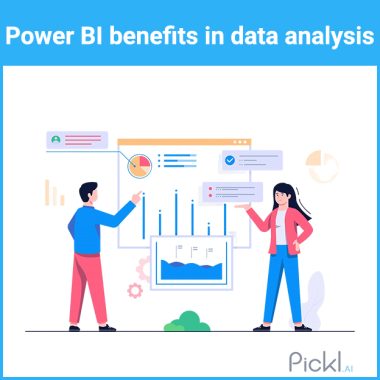Summary: Power BI is a business analytics tool transforming data into actionable insights. Key features include AI-powered analytics, extensive data connectivity, customisation options, and robust data modelling. It supports real-time analytics and offers interactive visualizations, making it a versatile tool for businesses of all sizes.
Introduction
Imagine you’re a business analyst at a fast-paced tech company, tasked with making sense of vast amounts of data generated daily.
You need to present actionable insights to your team, but the data is scattered across different platforms and formats. This is where Power BI comes into play—a powerful tool that transforms raw data into meaningful visualizations and reports, enabling you to make informed decisions quickly.
In this article, we will explore what Power BI is, its advantages and disadvantages, its architecture, components, features, and much more.
Key Takeaways
- It transforms raw data into actionable, interactive visualisations.
- It offers AI-driven analytics, including Natural Language Processing.
- Supports diverse data sources: Excel, SQL Server, Azure, and more.
- Customisable dashboards and reports enhance data presentation.
- Real-time analytics facilitates timely and informed decision-making.
Why Power BI?
The increasing need for businesses to make data-driven decisions has led to the rise of Business Intelligence (BI) tools like Power BI. It is a business analytics service provided by Microsoft that enables users to visualize data and share insights across their organization or embed them in an app or website.
It allows users to connect to various data sources, transform raw data into interactive dashboards and reports, and perform Data Analysis using a user-friendly interface.
Also, it supports a wide range of data sources, including Excel spreadsheets, cloud services like Azure, and on-premises databases.
Components of Power BI
Power BI comprises several key components, including Power BI Desktop for report creation, Power BI Service for sharing insights, Power Query for data transformation, and Power View for interactive visualizations. These components work together to facilitate effective data analysis.
- Power BI Desktop: A Windows application used for creating reports.
- Power Query: A tool for data connection and transformation.
- Power Pivot: A data modelling feature allowing advanced calculations.
- Power View: An interactive visualization tool.
- Power Map: A geospatial visualization tool for mapping data.
- Power BI Service: The online platform for sharing reports.
- Mobile Apps: Applications available for iOS and Android devices for accessing reports on-the-go.
Features of Power BI
It is a powerful Business Intelligence tool that offers a variety of features to help users analyse and visualize data effectively. Here are some of the key features of Power BI:
User-Friendly Interface
It provides an intuitive interface that allows users to create reports and dashboards with minimal training. The drag-and-drop functionality makes it easy to build visualizations.
Real-Time Data Access
Users can connect to live data sources, enabling real-time updates on dashboards and reports. This feature ensures that decisions are based on the most current information available.
Multiple Data Source Connectivity
It supports a wide range of data sources, including Excel, SQL Server, cloud services like Azure, and various online services such as Google Analytics and Salesforce. This versatility allows users to consolidate data from different platforms.
Advanced Data Visualisation
It offers a variety of visualisation options, including charts, graphs, maps, and tables. Users can create interactive reports that facilitate deeper insights into their data.
Natural Language Querying (Q&A)
The Q&A feature allows users to ask questions about their data in natural language and receive instant visualizations as responses. This functionality makes data exploration accessible to non-technical users.
Advantages of Power BI
It offers numerous advantages that make it a preferred choice for businesses looking to leverage data for informed decision-making. Here are some key benefits:
User-Friendly Interface
It is designed with an intuitive interface that allows users, regardless of technical expertise, to create reports and dashboards easily. The drag-and-drop functionality simplifies the process of data visualisation, enabling quick insights without extensive training.
Real-Time Data Access
One of the standout features is its ability to provide real-time data updates. Users can connect to live data sources, ensuring that the information presented in reports and dashboards is always current, which is crucial for making timely decisions in dynamic business environments.
Integration with Multiple Data Sources
It supports integration with a wide array of data sources, including cloud services, on-premises databases, and flat files like Excel. This versatility allows organizations to consolidate data from various platforms into a single view, enhancing analysis and reporting capabilities.
Advanced Data Visualisation
The platform boasts powerful visualisation tools that help users translate complex datasets into clear and interactive visual representations. This capability aids in identifying trends and patterns, making it easier for stakeholders to understand the data and derive actionable insights.
Collaboration Features
It facilitates seamless sharing of reports and dashboards among team members, promoting collaboration across departments. Users can publish their findings to the Power BI Service, allowing others to access insights easily and fostering a culture of data-driven decision-making within the organization.
Disadvantages of Power BI
Power BI, while a powerful Business Intelligence tool, has several disadvantages that organisations should consider. These are listed below:
Performance Issues
It can experience performance degradation when working with exceptionally large data models or complex calculations. It may face challenges when dealing with very large datasets, leading to slower response times.
The desktop app can be slow, especially when handling large datasets, which can delay report generation. It cannot process more than 20,000-30,000 rows without running into issues for some queries, sometimes timing out during processing.
Data Volume Limitations
It has strict limitations on the amount of data it can handle, particularly in its free and Pro versions.. Its Pro restricts the size of each dataset to 1 GB, which can be a significant bottleneck for organisations that need to work with large datasets.
Although Power BI Premium offers more storage capacity (up to 400 GB per dataset), even that may be insufficient for very large-scale operations. If data is larger than 2GB, extending the free version to the paid version is necessary.
Complex Licensing and Pricing
It has a multi-tiered pricing model with free, Pro, and Premium licenses. The complex licensing and pricing structure can be confusing and potentially expensive for businesses as they scale, particularly when multiple users or advanced features are needed.
Determining the appropriate licensing based on the scale of usage and the number of users can be complex, as costs can quickly add up for larger organisations.
Power BI Architecture
It consists of several key components that work together to facilitate Data Analysis:
- Data Sources: These include various databases (SQL Server, Oracle), cloud services (Azure, Salesforce), and flat files (Excel).
- Power Query: This tool allows users to connect to data sources and perform data transformation tasks such as cleaning and shaping the data before analysis.
- Data Model: The transformed data is stored in a data model where relationships between different datasets can be established for comprehensive analysis.
- Power BI Service: This is the online platform where users can publish reports and dashboards for sharing across teams or organizations.
- Power BI Desktop: A desktop application used for creating reports and dashboards offline before publishing them to the Power BI Service.
Power BI Service
The Power BI Service is a cloud-based platform that enables users to share insights through interactive dashboards and reports. It provides features such as:
- Collaboration Tools: Users can share reports with colleagues or stakeholders easily.
- Content Packs: Pre-built templates that allow users to quickly set up reports based on popular services like Google Analytics or Salesforce.
- Mobile Access: Users can access their reports on mobile devices through the its mobile app.
- Scheduled Data Refreshes: Users can schedule automatic updates for their datasets to ensure they always have the latest information available.
Power BI Dashboard
A Power BI dashboard is a single-page view that provides an overview of key metrics through visualizations such as charts, graphs, and maps. Key features include:
- Real-Time Updates: Dashboards can display real-time data from connected sources.
- Interactive Visuals: Users can click on visuals to drill down into more detailed reports.
- Custom Layouts: Dashboards can be customized according to user preferences with drag-and-drop functionality.
- Alerts: Users can set alerts based on specific metrics or thresholds so they are notified when significant changes occur.
Conclusion
In summary, Microsoft Power BI is a powerful Business Intelligence tool that transforms how organizations analyse and visualize their data.
Its user-friendly interface combined with robust capabilities makes it an ideal choice for businesses looking to harness insights from their datasets effectively. While there are some disadvantages related to learning curves and performance issues with large datasets, the advantages far outweigh these concerns for most users.
For organizations seeking industry-specific solutions or tailored analytics capabilities, exploring custom implementations of Power BI could yield significant benefits in decision-making processes.
Frequently Asked Questions
How Does Power BI Work?
It connects to various data sources, transforms raw data into visualizations using its tools like Power Query and Data Model, then presents this information through interactive dashboards in the Power BI Service.
What Types of Data Sources Does Power BI Support?
It supports a wide range of sources including SQL databases, Excel files, cloud services like Azure and Salesforce, APIs, and more.
Can Power BI Handle Real-Time Data?
Yes, it allows real-time access to live data streams which enables up-to-date reporting and monitoring of key metrics.
Is There a Free Version of Power BI?
Yes, Microsoft offers a free version of Power BI Desktop which allows individuals to create reports; however, sharing capabilities require a paid subscription.
What Industries Benefit Most from Using Power BI?
Industries such as finance, healthcare, retail, marketing analytics, and manufacturing benefit significantly from using Power BI due to its ability to provide actionable insights from complex datasets.




